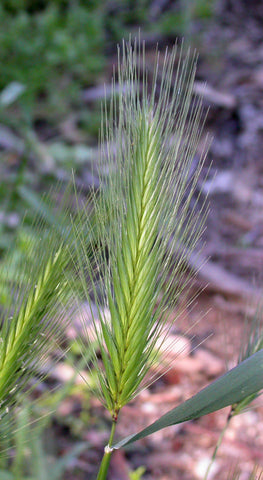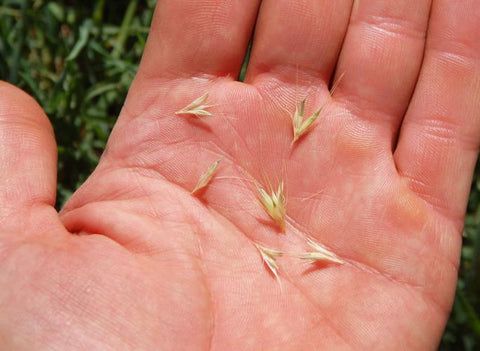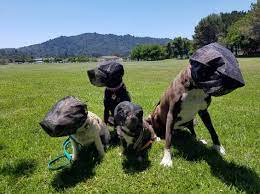As spring approaches, foxtails are once again starting to emerge. Foxtails describe a type of invasive grass that produce a cluster of spiky seeds - there are a variety of species of foxtails that can be found across North America. The seed heads include tiny barbs that are designed to help the seeds travel - a great evolutionary advantage! Unfortunately, foxtails pose a significant threat to dogs, as their barbed seed heads can easily penetrate a dog’s body through the nose, mouth, ears, eyes, or skin, or between the toes. Once they enter, foxtails can migrate inside your dog’s body and cause severe internal injuries. With the growing prevalence of foxtails, it’s critical to understand how to prevent foxtail injury to your dog.
Here are some essential tips for minimizing the risk of foxtail injury. Remember, prevention is key!

Where and When Foxtails Grow
Familiarize yourself with foxtails and their common locations. Foxtails aren’t just an issue out on the trails - they are highly prevalent in urban and suburban areas as well! They thrive along roadsides, sidewalks, near trailheads, and in open fields (and yes, dog parks - one more reason to avoid them!). Stay vigilant during walks and keep your dog leashed and away from areas where foxtails grow.
Since foxtails are more prevalent in open, disturbed areas, you may consider exploring less-traveled or out of the way locations for your hikes. For urban walks, consider shorelines, open paved areas, or manicured lawns. See our blog about locations for enrichment outings for more ideas. For hikes, trails in redwood groves or shady riparian areas MAY have fewer foxtails.
Foxtails may be abundant for the first several hundred meters of a trail, but become less prevalent as you venture farther away from the road, into less disturbed native habitat. Consider keeping your dog on leash and/or use an OutFox for Dogs Hood (more info below) for the first several minutes of a hike, until you’re seeing mostly native grasses and trees.
Be aware of the foxtail life cycle. Foxtails start their life cycle as vibrant green plants, with seed heads that are relatively soft and flexible. Keep a close eye early in the spring season for the emergence of foxtails. As the season progresses, the seeds dry up and fall from the plant, scattering their barbed seeds across the ground. Because of this, foxtail hazards persist well into the fall and winter months, making it crucial for dog owners to remain vigilant for most of the year. I personally have found that the risk of foxtail exposure and injury increases later in the season as the foxtail plants move through their life cycle and more dry, hardened seeds are scattered along the ground, even far from the original plant. Summer and fall are peak foxtail hazard seasons.

Grooming Tips
We have found that long haired dogs and dogs with lighter fur are more susceptible to foxtail injury, as the dried seeds blend in and are harder to see. If your dog has long fur, opt for a short haircut, especially on their feet, which is sometimes referred to as a “poodle cut.” Keep your dog well-groomed and free of mats or tangled fur to minimize the chances of foxtail entanglement. Find a qualified force free groomer in your area and prioritize cooperative care at home. If your dog is comfortable with handling, you are much more likely to find and remove a foxtail before it has a chance to enter your dog.
After each hike or walk, thoroughly check your dog for foxtails, through their fur, between all of their toes, and around the eyes/ears/nose/mouth. Inspect your dog regularly, even if you have not just been on a walk. Sometimes foxtails can migrate from the fur into the skin days after an outing. Again, be especially vigilant with light-haired or long haired dogs, as foxtail entry is more likely to go unnoticed due to their ability to blend in with their fur.

Paws (especially on the top of the foot between the toes) are prime locations for foxtail entry.
Signs of Foxtail Entry
Be alert to symptoms indicating foxtail entry or ingestion, such as coughing, wheezing, gagging, sneezing, pawing at the eyes or ears, head shaking, redness between the toes, or excessive licking. Look for any signs of irritation, such as redness, swelling, or discharge. An inflamed “pinhole” between the toes or anywhere on the skin is a clear indication of foxtail entry. If your dog seems to be licking their paws more than usual, this could be a sign of a foxtail issue.
My Dog Ate a Foxtail, What Do I Do?
If you suspect a foxtail injury, call your vet immediately. Try to prevent your dog from licking or pawing at the area. With foxtails, early intervention is crucial to prevent more serious complications. Don’t delay! The longer you wait, the farther inside your dog's body a foxtail may travel. Your vet will advise you on the next step to take - in some cases, they may recommend visiting the nearest emergency vet (if you’re traveling, consider keeping the number for the nearest emergency vet programmed into your phone to contact in case of suspected foxtail entry).
If your vet suspects a foxtail injury, they may need to sedate your dog to remove it. In extreme cases, endoscopy or exploratory surgery may be needed to attempt to remove a foxtail. While it's sometimes possible for your dog to pass a foxtail if swallowed, that is not always the case!
Given all this - if you haven’t yet, we strongly urge you to consider pet insurance, especially if you live in an area where foxtails are prevalent. Surgery to remove a foxtail can cost thousands of dollars.

Foxtail Prevention using an OutFox Hood
Consider outfitting your dog with protective gear such as an OutFox hood by @outfoxfordogs. This lightweight mesh hood provides a barrier against foxtail entry through the eyes, ears, nose and mouth and can significantly reduce the risk of injury. Ensure the OutFox hood fits properly and comfortably on your dog. Adjust the straps as needed to achieve a snug yet comfortable fit.
If your dog is not used to wearing an OutFox hood, take your time helping your dog get used to the hood. Important note: Dogs with any handling or body sensitivities will need a very slow and careful approach. If you’re having trouble or your dog is showing any signs of stress or avoidance around the hood, consult a qualified force free trainer to help.
Practice taking the hood on and off at home and be generous with treats before, during, and after. Practice in short (1-2) minute sessions at home. If your dog tolerates the hood, work up to having your dog wear the hood for longer stretches, and practice taking the hood on and off in new environments. Gradually expose your dog to different environments while wearing the hood, starting with familiar surroundings. Always pair the hood with something your dog loves, like treats! Monitor your dog's behavior while wearing the hood to ensure they are not distressed or uncomfortable. It can take some practice, but it is possible to deliver treats while your dog is wearing an OutFox hood! Try tucking the treat under the lip of the hood and letting it drop to the bottom. If your dog knows the “find it” cue or a similar cue to forage for food on the ground, use that cue to encourage your dog to drop their head to the ground so the treat can fall to the bottom of the hood.
Something very important to note about the OutFox hood is that it may affect your dog’s heat tolerance. Since you’re likely to be using it during the warmer months, it’s critical to monitor your dog and take frequent breaks to prevent overheating. Take plenty of shade and water breaks. Watch for signs of heat stress, such as excessive panting, lethargy, or difficulty breathing, and remove the hood if your dog shows any signs of distress.
Booties or lightweight protective clothing can offer added protection in foxtail-prone areas.
More Prevention Tips
During peak foxtail season, it’s best to keep your dog on a leash or a long line. Monitor them closely and do your best to keep them on the trail. If a trail is littered with foxtails when you arrive, skip the hike or choosing a new location! There are many trails that I simply won’t visit during foxtail season, and I adapt our walking locations based on the time of year.
Remember, prevention is key when it comes to foxtail injuries. Stay vigilant - your pup will thank you for it! 🐾

